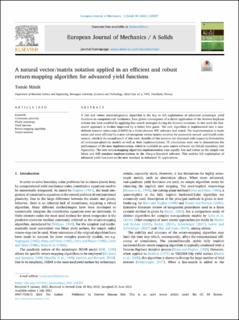| dc.contributor.author | Manik, Tomas | |
| dc.date.accessioned | 2022-02-14T12:46:21Z | |
| dc.date.available | 2022-02-14T12:46:21Z | |
| dc.date.created | 2021-09-01T21:43:02Z | |
| dc.date.issued | 2021 | |
| dc.identifier.citation | European Journal of Mechanics. A, Solids. 2021, 90 . | en_US |
| dc.identifier.issn | 0997-7538 | |
| dc.identifier.uri | https://hdl.handle.net/11250/2978801 | |
| dc.description.abstract | A fast and robust stress-integration algorithm is the key to full exploitation of advanced anisotropic yield functions in computational mechanics. Poor global convergence of a direct application of the Newton-Raphson scheme has been rectified by applying line search strategies during the Newton iterations. In this work the line-search approach is further improved by a better first guess. The new algorithm is implemented into a user-defined material subroutine (UMAT) in a finite-element (FE) software and tested. The implementation is made easier and more efficient by a new advantageous vector/matrix notation for symmetric second- and fourth-order tensors, which is the second result of this work. Benefits of this notation are discussed with respect to formulation of continuum-plasticity models as well as their implementations. FE simulations were run to demonstrate the performance of the new implementation, which is available as open-source software via GitLab repository (see Appendix). The new return-mapping algorithm implementation runs equally fast and robust as the simple von Mises and Hill standard implementations in the Abaqus/Standard software. This enables full exploitation of advanced yield functions as the new standard in industrial FE applications. | en_US |
| dc.language.iso | eng | en_US |
| dc.publisher | Elsevier | en_US |
| dc.rights | Navngivelse 4.0 Internasjonal | * |
| dc.rights.uri | http://creativecommons.org/licenses/by/4.0/deed.no | * |
| dc.title | A natural vector/matrix notation applied in an efficient and robust return-mapping algorithm for advanced yield functions | en_US |
| dc.type | Peer reviewed | en_US |
| dc.type | Journal article | en_US |
| dc.description.version | publishedVersion | en_US |
| dc.source.pagenumber | 21 | en_US |
| dc.source.volume | 90 | en_US |
| dc.source.journal | European Journal of Mechanics. A, Solids | en_US |
| dc.identifier.doi | 10.1016/j.euromechsol.2021.104357 | |
| dc.identifier.cristin | 1930647 | |
| dc.relation.project | Norges forskningsråd: 315727 | en_US |
| cristin.ispublished | true | |
| cristin.fulltext | original | |
| cristin.qualitycode | 1 | |

